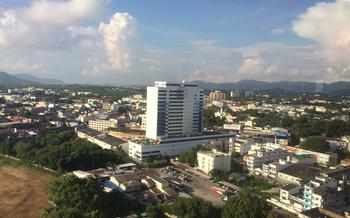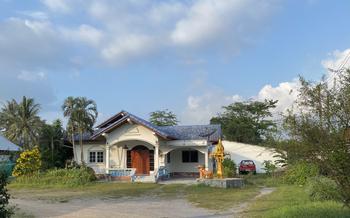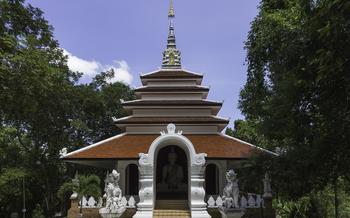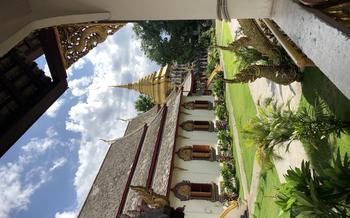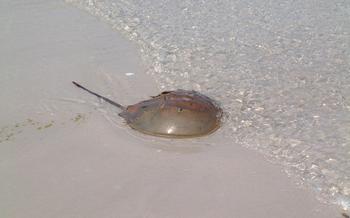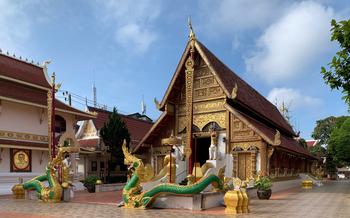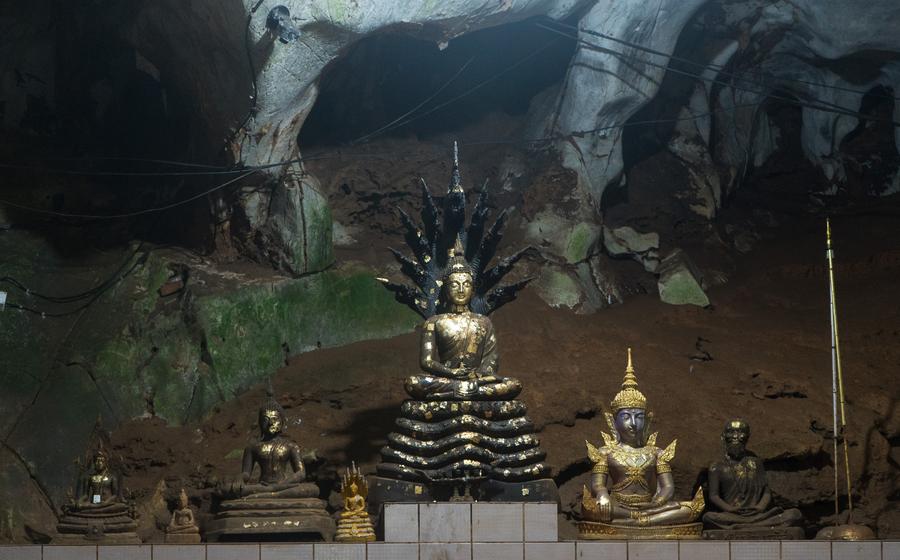
Chiang Dao Cave
- Chiang Dao Cave: A Majestic Limestone Wonder
- Unveiling the Cave's History and Lore
- Exploring the Cave's Geological Marvels:
- Witnessing the Cave's Spiritual Aura:
- Discovering the Cave's Rare Wildlife
- Chiang Dao Cave's Practical Information
- Essential Packing Tips for Cave Exploration
- Delving into the Cave's Cultural Significance
- Exploring the Surrounding Area's Charms
- Chiang Dao Cave's Role in Conservation
- Local Wisdom and Cave Etiquette
- Unforgettable Moments in Chiang Dao Cave:
- Inspiring Cave Photography
- Insider Tip: Unveiling Hidden Gems
Chiang Dao Cave: A Majestic Limestone Wonder
The Chiang Dao Cave, nestled in the heart of Chiang Dao Wildlife Sanctuary, stands as a testament to nature's artistry and geological wonders. Formed over millions of years by the relentless work of underground water erosion, this awe-inspiring limestone cave system beckons travelers with its intricate chambers, hidden passages, and stunning natural formations.
Geological Formation and History: The Chiang Dao Cave's remarkable existence can be traced back to the Paleozoic Era, when the region was submerged beneath a shallow sea. Over time, layers of sediment, primarily composed of calcium carbonate from marine organisms, accumulated on the seabed, forming a thick layer of limestone. As tectonic shifts pushed the land upwards, the limestone was exposed to weathering and erosion, giving rise to the cave's intricate network of tunnels and chambers.
Spiritual and Cultural Significance: Beyond its geological significance, the Chiang Dao Cave holds deep spiritual and cultural importance for the local communities. It is revered as a sacred site, believed to be inhabited by spirits and deities. Throughout history, the cave has served as a place of worship, meditation, and pilgrimage for both Buddhist monks and local villagers.
Unique Cave Features and Formations: The Chiang Dao Cave's interior is a treasure trove of natural wonders. Visitors are greeted by a mesmerizing array of stalactites and stalagmites, formed by the slow dripping of mineral-rich water over millennia. These intricate formations, resembling frozen waterfalls and towering columns, create a breathtaking spectacle of natural sculpture.
Practical Information for Visitors: To ensure a safe and enjoyable exploration, visitors are advised to come prepared. Sturdy shoes, comfortable clothing, and a flashlight or headlamp are essential. Guided tours are available, providing valuable insights into the cave's history, geology, and cultural significance. The cave is accessible year-round, with varying admission fees for adults and children.
Unveiling the Cave's History and Lore
Chiang Dao Cave is steeped in a rich tapestry of ancient legends, folklore, and archaeological discoveries. According to local tales, the cave was once the abode of a powerful spirit known as the "Lord of the Cave." Offerings and ceremonies were held to appease the spirit and seek its blessings. Archaeological excavations have revealed evidence of human habitation dating back to prehistoric times, suggesting the cave's significance as a shelter and gathering place for ancient communities.
In local beliefs and traditions, the cave holds a special place. It is considered a sacred site, where spirits reside and prayers are answered. Many locals visit the cave to pay homage, make offerings, and seek spiritual guidance. The cave's spiritual aura and connection to the spirit world make it a revered destination for those seeking a deeper connection to their cultural roots.
The cave's history is also intertwined with regional events. During the tumultuous Lanna Kingdom era, the cave served as a refuge for those seeking shelter from conflicts and invasions. Its hidden chambers and secluded location provided a safe haven for people to retreat and regroup. The cave's strategic significance and role in regional history add to its allure, making it a site of cultural and historical importance.
Exploring the Cave's Geological Marvels:
Chiang Dao Cave's geological marvels are a testament to nature's artistic prowess. Its formation is the result of millions of years of water seeping through limestone, slowly dissolving the rock and creating the intricate cave system we see today. The cave's walls are adorned with impressive stalactites and stalagmites, which form when water drips from the ceiling and deposits minerals, gradually building these majestic columns.
The cave also features an underground river and crystal-clear pools, adding to its allure. The water's gentle flow and the reflections of the cave walls create a mesmerizing spectacle. Additionally, the cave boasts unique chambers and galleries, each with its own distinct formations and characteristics. These chambers range from intimate and cozy spaces to vast and awe-inspiring halls, offering a diverse and captivating experience for visitors.
Witnessing the Cave's Spiritual Aura:
Chiang Dao Cave holds a profound spiritual significance for the local community and visitors alike. Revered as a sacred site, the cave is adorned with Buddhist shrines, where devotees offer prayers, light candles, and leave offerings to seek blessings and pay homage. These shrines, often adorned with colorful flowers, incense sticks, and sacred images, create a serene and contemplative atmosphere within the cave's chambers.
Local ceremonies and rituals are frequently held within the cave, further emphasizing its spiritual importance. These ceremonies, often led by Buddhist monks or local spiritual leaders, involve chanting, meditation, and the offering of food and flowers to pay respect to the cave's spirits and deities. Visitors are welcome to observe these ceremonies, gaining a deeper understanding of the local beliefs and traditions associated with the cave.
The cave's spiritual aura is palpable, inviting visitors to pause and reflect on their inner selves. Whether through meditation, prayer, or simply absorbing the tranquil atmosphere, the Chiang Dao Cave offers a unique opportunity for spiritual exploration and connection.
Discovering the Cave's Rare Wildlife
Chiang Dao Cave is renowned not only for its geological wonders but also for its diverse and unique wildlife. The cave ecosystem supports a wide variety of cave-dwelling species, each adapted to the unique conditions of this subterranean world.
Bats are one of the most common inhabitants of the cave. Thousands of bats, including several threatened and endangered species, roost within the cave's chambers. Their high-pitched calls and fluttering wings create a symphony of sound that adds to the cave's eerie atmosphere.
In addition to bats, the cave is home to a variety of insects, including crickets, beetles, and spiders. These insects play a crucial role in the cave's ecosystem, breaking down organic matter and providing food for other cave-dwelling creatures.
One of the most fascinating creatures found in Chiang Dao Cave is the blind cave fish. This small, translucent fish has evolved to survive in the cave's dark, nutrient-poor waters. It lacks eyes and relies on its highly developed senses of touch and smell to navigate its surroundings.
The presence of these unique and diverse species highlights the importance of protecting Chiang Dao Cave and its ecosystem. Conservation efforts are underway to ensure the survival of these cave-dwelling creatures and preserve the delicate balance of the cave's environment.
Chiang Dao Cave's Practical Information
Location and Accessibility:
Chiang Dao Cave is situated in Chiang Dao Wildlife Sanctuary, approximately 70 kilometers north of Chiang Mai city. It is easily accessible by road, and visitors can either rent a car or take a bus from Chiang Mai to Chiang Dao town. From there, local transportation, such as songthaews or taxis, can be arranged to reach the cave entrance.
Entrance Fees and Visiting Hours:
The cave is open to visitors daily from 8:00 AM to 4:00 PM. The entrance fee is 40 baht for foreign tourists and 20 baht for Thai nationals. It is advisable to arrive early to avoid crowds, especially during peak tourist season.
Guided Tour Options and Availability:
Guided tours are available for visitors who wish to explore the cave's deeper chambers and learn more about its history and significance. Tours are conducted by experienced local guides who can provide insights into the cave's geological formations, cultural importance, and resident wildlife. Guided tours typically last for around 45 minutes to an hour and are an excellent way to maximize your cave exploration experience.
Recommended Time for Exploration:
The recommended time for exploring Chiang Dao Cave is around 1-2 hours. This allows sufficient time to walk through the main chambers, admire the cave formations, and learn about the cave's history and significance. If you are particularly interested in photography or wildlife observation, you may want to allocate more time for your visit.
Essential Packing Tips for Cave Exploration
When embarking on a cave exploration adventure, it's crucial to be well-prepared with the appropriate gear. Here are some essential packing tips to ensure a comfortable and safe journey:
-
Comfortable Clothing and Footwear: Choose lightweight, breathable clothing that allows for freedom of movement. Avoid wearing shorts or sandals, as you may encounter rough terrain or slippery surfaces. Opt for sturdy hiking shoes or boots with good traction to navigate uneven cave floors.
-
Water Bottles and Snacks for Hydration: Bring sufficient water to stay hydrated during your exploration. Pack energy bars, granola, or fruit to replenish your energy levels. Avoid salty or sugary snacks, as they can increase thirst.
-
Flashlights or Headlamps for Illumination: A reliable flashlight or headlamp is a must-have for cave exploration. The cave's interior is often dark, and natural light may not penetrate deep into the chambers. Choose a headlamp for hands-free illumination while navigating narrow passages or climbing obstacles.
-
Camera for Capturing Cave's Wonders: If you're passionate about photography, bring a camera to capture the cave's mesmerizing beauty. A tripod can help stabilize your camera for long exposures, allowing you to capture stunning shots of cave formations and unique perspectives.
Delving into the Cave's Cultural Significance
Chiang Dao Cave holds immense cultural significance for the local communities and beyond. It is deeply embedded in the region's myths and legends, serving as a place of worship and pilgrimage. The cave's spiritual aura and connection to ancient beliefs have made it a revered site, attracting visitors from far and wide.
Local folklore is replete with tales of mythical creatures and spirits that inhabit the cave. These legends have been passed down from generation to generation, weaving a tapestry of cultural heritage around the cave. The cave's unique rock formations and chambers have inspired countless stories, adding to its mystique and allure.
Throughout history, the cave has been a site for important ceremonies and rituals, further solidifying its cultural significance. Local communities gather within the cave to pay homage to the spirits and deities believed to reside there. These ceremonies often involve offerings, prayers, and traditional performances, showcasing the deep reverence and respect held for the cave.
Chiang Dao Cave's cultural significance extends beyond its spiritual and religious dimensions. It has played a pivotal role in shaping the region's identity and traditions. The cave has served as a meeting place for villagers, a refuge during times of conflict, and a source of inspiration for local artists and storytellers.
Exploring the cave's cultural significance offers visitors a glimpse into the rich tapestry of Thai folklore, beliefs, and traditions. It is an opportunity to connect with the local community and gain a deeper understanding of the region's cultural heritage.
Exploring the Surrounding Area's Charms
Beyond the allure of the Chiang Dao Cave itself, the surrounding area offers a wealth of attractions that beckon travelers to delve deeper into the region's cultural tapestry and natural wonders. Majestic temples adorned with intricate carvings and shimmering stupas stand as testaments to the area's rich religious heritage. Take a leisurely stroll through these sacred grounds, marveling at their architectural grandeur and the serene aura that envelops them.
For those seeking an adventurous escape, the lush forests and rolling hills surrounding Chiang Dao Cave offer a haven for trekking and hiking enthusiasts. Embark on invigorating trails that wind through verdant landscapes, leading to hidden waterfalls, secluded viewpoints, and breathtaking panoramas that will leave you in awe. Immerse yourself in the symphony of nature, where the rustling of leaves, the chirping of birds, and the gentle murmur of streams create a soothing soundtrack for your exploration.
Indulge in the region's thermal wonders by visiting the nearby hot springs, where you can soak in naturally heated pools and let your worries melt away. Surrender to the tranquility of these natural havens, allowing the warm, mineral-rich waters to rejuvenate your body and mind. The soothing ambiance and picturesque surroundings will transport you to a state of pure relaxation and bliss.
As you delve deeper into the Chiang Dao region, discover unique cultural experiences that showcase the vibrant traditions and warm hospitality of the local people. Visit traditional villages, where you can witness artisans crafting intricate handicrafts, learn about their way of life, and savor delicious local cuisine that will tantalize your taste buds. Engage in cooking classes to master the art of Thai cooking, immersing yourself in the culinary delights of this vibrant region.
Chiang Dao is a treasure trove of natural and cultural wonders that complement the allure of the enchanting Chiang Dao Cave. Embrace the opportunity to explore this captivating region, where every corner holds a new adventure, a fascinating story, and unforgettable experiences that will leave an enduring mark on your soul.
Chiang Dao Cave's Role in Conservation
Chiang Dao Cave stands as a testament to the importance of conservation efforts in preserving natural wonders. The cave's intricate formations and delicate ecosystem require careful protection to ensure their longevity. Conservation initiatives have been implemented to safeguard the cave's unique features and protect its diverse wildlife. These initiatives include:
-
Cave Ecosystem Monitoring: Regular monitoring of the cave's environment, including water quality, temperature, and humidity, ensures that conditions remain optimal for the survival of cave-dwelling species.
-
Sustainable Tourism Practices: The promotion of responsible tourism practices minimizes the impact of visitors on the cave's ecosystem. Guided tours are conducted in a manner that respects the cave's delicate formations and minimizes disturbance to wildlife.
-
Education and Awareness: Raising awareness about the importance of cave conservation among visitors and local communities is crucial. Educational programs and signage help visitors understand the significance of the cave and the need to protect its natural beauty.
-
Collaboration with Local Communities: Conservation efforts involve close collaboration with local communities, who play a vital role in protecting the cave and its surroundings. Their traditional knowledge and practices contribute to the sustainable management of the cave's ecosystem.
-
Research and Conservation Projects: Ongoing research projects focus on understanding the cave's geology, hydrology, and biodiversity. This research informs conservation strategies and helps identify potential threats to the cave's ecosystem.
Local Wisdom and Cave Etiquette
When exploring Chiang Dao Cave, it is essential to be mindful of local customs and beliefs to ensure a respectful and harmonious experience. Maintaining a quiet and reverent atmosphere is crucial, as the cave is considered a sacred site by the local community. Whispering or speaking softly helps preserve the tranquility of the cave and allows everyone to appreciate its beauty and spiritual significance.
Respecting the cave's natural formations is paramount. Avoid touching or damaging the delicate stalactites and stalagmites, as they are irreplaceable and take thousands of years to form. Proper disposal of waste is essential to protect the cave's pristine environment. Always carry out any trash or food wrappers, leaving no trace of your visit. By respecting local customs and the cave's natural wonders, visitors can contribute to its preservation and ensure its beauty remains intact for future generations.
Unforgettable Moments in Chiang Dao Cave:
Venturing into Chiang Dao Cave was an experience that surpassed all expectations. As I navigated through its labyrinthine chambers, each turn revealed a new wonder. The cave's grandeur unfolded before my eyes - towering stalactites descended from the ceiling like ancient chandeliers, while glistening stalagmites rose from the ground like mystical pillars. The interplay of light and shadow cast an ethereal glow, transforming the cave into a cathedral of natural wonders.
Amongst the many awe-inspiring moments, one stands out vividly. As I reached a particularly secluded chamber, I stumbled upon a hidden pool of crystal-clear water. Its surface shimmered under the dim light, reflecting the intricate patterns of the cave walls. In that instant, I felt a profound connection with the cave's ancient past and the countless beings who had journeyed through its depths. It was a moment of pure awe and tranquility, etched indelibly in my memory.
Another unforgettable experience occurred during a guided night tour. With only headlamps to illuminate our path, we ventured deep into the cave's unexplored regions. The darkness enveloped us, creating a sense of mystery and adventure. As we progressed, our guide pointed out hidden crevices and secret passages, revealing the cave's hidden depths. The thrill of exploring the unknown and witnessing the cave's pristine beauty under the cloak of darkness made this night tour an unforgettable experience.
Chiang Dao Cave offered a wealth of unforgettable moments, each adding to the magic and wonder of the exploration. From discovering hidden chambers to marveling at the cave's intricate formations, every twist and turn revealed a new treasure. It was an experience that left me with a deep appreciation for the natural world and a lasting memory of the cave's enchanting allure.
Inspiring Cave Photography
Chiang Dao Cave presents a photographer's paradise, offering an array of opportunities to capture its mesmerizing beauty. To make the most of your photography experience, consider the following tips:
-
Embrace Low-light Photography: The cave's dimly lit environment calls for low-light photography techniques. Use a tripod to steady your camera, and experiment with long exposure times to capture the cave's ethereal aura.
-
Compose Striking Shots: Pay attention to composition when framing your shots. Look for interesting angles and perspectives that highlight the cave's unique features. Experiment with different focal lengths to achieve varying depths of field.
-
Capture the Cave's Essence: Beyond capturing individual formations, strive to capture the cave's overall ambiance. Photograph the interplay of light and shadow, the vastness of its chambers, and the intricate patterns created by the stalactites and stalagmites.
-
Utilize Natural Light: While flash photography is permitted in some areas of the cave, using natural light can yield more dramatic and authentic results. Position yourself near openings where sunlight filters in, creating stunning silhouettes and illuminating the cave's hidden corners.
Insider Tip: Unveiling Hidden Gems
While Chiang Dao Cave is a renowned attraction, venturing beyond its fame reveals a treasure trove of hidden gems. Discover lesser-known caves in the region, each offering unique experiences. Explore secret trails that lead to breathtaking viewpoints, where you can soak in panoramic vistas of the surrounding landscape. Seek recommendations from locals, who often know of secluded spots that remain untouched by mass tourism. Experience the cave's serene atmosphere during off-peak hours, when you can immerse yourself in its tranquility and capture its beauty without the crowds.

